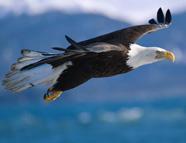
Looking Ahead: Eagle Vision
If you swapped your eyes for an eagle’s, you could see an ant crawling on the ground from the roof of a 10-story building. You could make out the expressions on basketball players’ faces from the worst seats in the arena. Objects directly in your line of sight would appear magnified, and everything would be brilliantly colored, rendered in an inconceivable array of shades.
The more scientists learn about eagle vision, the more awesome it sounds. Thanks to developing technologies, some aspects of their eyesight may eventually be achievable for humans. Others, we can only imagine.
Eagles and other birds of prey can see four to five times farther than the average human can, meaning they have 20/5 or 20/4 vision under ideal viewing conditions. Scientists have to cook up special experiments to judge eagles’ eyesight — your optometrist’s alphabet eye charts are of no use, after all — and one common setup involves training the birds to fly down a long tunnel toward two TV screens. One screen displays a striped pattern, and the birds get a treat when they land on it. Scientists test their acuity by varying the width of the stripes and determining from what distance the eagles begin to veer in the correct direction.
According to William Hodos, a distinguished professor emeritus at the University of Maryland who has studied the visual acuity of birds since the 1970s, two eyeball features confer eagles’ sharper vision. First, their retinas are more densely coated with light-detecting cells called cones than human retinas, enhancing their power to resolve fine details just as higher pixel density increases the resolving power of cameras.
Second, they have a much deeper fovea, a cone-rich structure in the backs of the eyes of both humans and eagles that detects light from the center of our visual field. According to Hodos, “Our fovea is a little shell or bowl, while in hawk or eagle it’s a convex pit. Some investigators think this deep fovea allows their eyes to act like a telephoto lens, giving them extra magnification in the center of their field of view.”
On top of sharp focus and a central magnifier, eagles, like all birds, also have superior color vision. They see colors as more vivid than we do, can discriminate between more shades, and can also see ultraviolet light — an ability that evolved to help them detect the UV-reflecting urine trails of small prey. But there’s no way to know what these extra colors, including ultraviolet, look like. “Suppose you wanted to describe the color of a tomato to someone who was born blind. You couldn’t do it. We can’t even guess what they’re subjective sensation of ultraviolet light is,” Hodos said.
Eagles’ high-flying lifestyle requires better vision than humans need, and the physical properties of our eyeballs limit us to 20/10 or 20/8 vision at best. Natural vision that good is extremely rare, but research by David Williams, director of the Center for Visual Science at the University of Rochester, and his colleagues may soon enable laser eye surgeons to achieve 20/10-or-better vision for a large percentage of patients, placing their visual acuity halfway between that of humans and eagles.
Williams and his colleagues use an instrument called a wavefront sensor to detect distortions in human vision. They shoot light into the eye and observe how it bounces back through hundreds of tiny lenses in the
sensor. The aberrations in patterns created by those lenses serve as a map of the eye’s mistakes. Customized surgical techniques are being developed to implement the results of patients’ wavefront measurements, in order to correct their vision beyond 20/20.
Excerpted from an article by Natalie Wolchover at www.LiveScience.com
*******
Have a thought about this article? Contact Us and let us know.